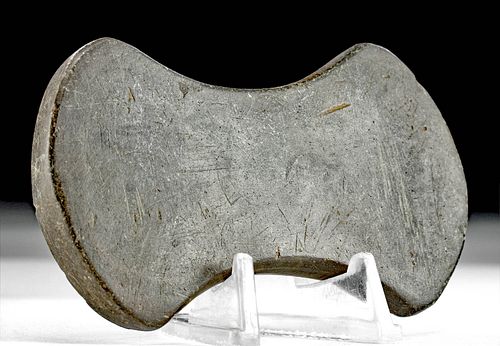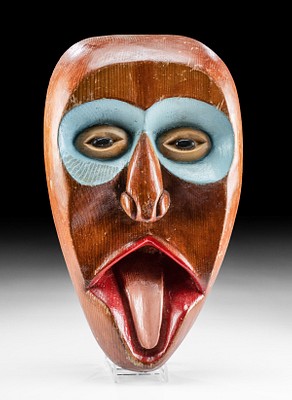Native American Eastern Woodland Archaic Bannerstone
Lot 76
About Seller
Artemis Gallery
686 S Taylor Ave, Ste 106
Louisville, CO 80027
United States
Selling antiquities, ancient and ethnographic art online since 1993, Artemis Gallery specializes in Classical Antiquities (Egyptian, Greek, Roman, Near Eastern), Asian, Pre-Columbian, African / Tribal / Oceanographic art. Our extensive inventory includes pottery, stone, metal, wood, glass and textil...Read more
Estimate:
$450 - $675
Absentee vs Live bid
Two ways to bid:
- Leave a max absentee bid and the platform will bid on your behalf up to your maximum bid during the live auction.
- Bid live during the auction and your bids will be submitted real-time to the auctioneer.
Bid Increments
| Price | Bid Increment |
|---|---|
| $0 | $25 |
| $300 | $50 |
| $1,000 | $100 |
| $2,000 | $250 |
| $5,000 | $500 |
| $10,000 | $1,000 |
| $20,000 | $2,500 |
| $50,000 | $5,000 |
| $100,000 | $10,000 |
| $200,000 | $20,000 |
About Auction
By Artemis Gallery
Sep 9, 2021
Set Reminder
2021-09-09 10:00:00
2021-09-09 10:00:00
America/New_York
Bidsquare
Bidsquare : Art & Artifacts of North America
https://www.bidsquare.com/auctions/artemis-gallery/art-artifacts-of-north-america-7436
Join us for a special auction not to be missed! Collectible Native American art from antiquity to mid-20th century, Spanish Colonial, Latin American, fine & folk art, American frontier items, and much more! Artemis Gallery info@artemisgallery.com
Join us for a special auction not to be missed! Collectible Native American art from antiquity to mid-20th century, Spanish Colonial, Latin American, fine & folk art, American frontier items, and much more! Artemis Gallery info@artemisgallery.com
- Lot Description
Native American, Midwestern United States, Michigan, Eastern Woodland, Archaic Period, ca. 5000 to 1000 BCE. A fine example of a bannerstone preform, a tool or weight for an atlatl, with a bowtie shape. This bannerstone is made from a dark gray banded slate and polished with smooth and rounded edges. This stone has crescent shaped wings like a butterfly or a bowtie but is not drilled laterally through the cross-section which indicates this is unfinished, hence the preform designation. Bannerstones remain an archaeological mystery. For many years, inspired by research done by a former physicist, archaeologists believed that bannerstones were used as weights to give atlatls greater power and control for throwing spears. Later experimental archaeology proved that this was not true - but did open the possibility that the bannerstone helped with fatigue when holding an atlatl still, while stalking skittish prey such as deer. Bannerstones of various sizes and shapes, including bowtie or fluted, have been found across the eastern part of North America. Size: 3.5" L x 0.25" W x 2" H (8.9 cm x 0.6 cm x 5.1 cm)
Provenance: private southwestern Pennsylvania, USA collection, acquired prior to 2000
All items legal to buy/sell under U.S. Statute covering cultural patrimony Code 2600, CHAPTER 14, and are guaranteed to be as described or your money back.
A Certificate of Authenticity will accompany all winning bids.
PLEASE NOTE: Due to recent increases of shipments being seized by Australian & German customs (even for items with pre-UNESCO provenance), we will no longer ship most antiquities and ancient Chinese art to Australia & Germany. For categories of items that are acceptable to ship to Australia or Germany, please contact us directly or work with your local customs brokerage firm.
Display stands not described as included/custom in the item description are for photography purposes only and will not be included with the item upon shipping.
#160218Nicks and surface scratches. Loss and chips to verso face. Find site written on surface. Old traces of adhesive residue from mounting or displaying.Condition
- Shipping Info
-
All shipping is handled in-house for your convenience. Your invoice from Artemis Gallery will include shipping calculation instructions. If in doubt, please inquire BEFORE bidding for estimated shipping costs for individual items.
-
- Buyer's Premium



 EUR
EUR CAD
CAD AUD
AUD GBP
GBP MXN
MXN HKD
HKD CNY
CNY MYR
MYR SEK
SEK SGD
SGD CHF
CHF THB
THB













